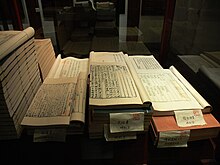
Back شرعوية (فلسفة صينية) Arabic شرعويه ARZ Legizm Azerbaijani Легизъм Bulgarian আইনবাদ (চীনা দর্শন) Bengali/Bangla Lezennouriezh (prederouriezh sinaat) Breton Escola de les lleis Catalan Legismus Czech Legalismus German Κινεζικός νομικισμός Greek
This article may need to be rewritten to comply with Wikipedia's quality standards. (November 2024) |
This article may be too technical for most readers to understand. (November 2024) |
| Legalism | |||||||||||||||||||||||
|---|---|---|---|---|---|---|---|---|---|---|---|---|---|---|---|---|---|---|---|---|---|---|---|
 Statue of the legalist Shang Yang | |||||||||||||||||||||||
| Chinese | 法家 | ||||||||||||||||||||||
| Literal meaning | School of law | ||||||||||||||||||||||
| |||||||||||||||||||||||
| Part of a series on |
| Chinese legalism |
|---|
 |
Fajia (Chinese: 法家; pinyin: fǎjiā), or the School of fa (laws, methods), often translated as Legalism,[1] is a school of mainly Warring States period classical Chinese philosophy. Often interpreted in the West along realist lines, its members works contributed variously to the formation of the bureaucratic Chinese empire, and early elements of Daoism. The later Han takes Guan Zhong, associated with the Guanzi, as forefather of the Fajia. Its more Legalistic figures include ministers Li Kui and Shang Yang, and more Daoistic figures Shen Buhai and philosopher Shen Dao,[2] with the late Han Feizi drawing on both. Later centuries took Xun Kuang as a teacher of Han Fei and Li Si.[3] Succeeding emperors and reformers often followed the templates set by Han Fei, Shen Buhai and Shang Yang, but the Qin to Tang were more characterized by their traditions.
Though Chinese administration had no single origin, with a major influence by the Han dynasty, grand chancellor Shen Buhai likely played a key role in the development of the merit system, and could be seen as its founder. With formative influence for the Qin and Chinese law, Shang Yang reformed the peripheral Qin state into a strongly centralized, powerful kingdom, ultimately unifying China in 221 BCE. Largely responsible for their synthesis as a school, the Han Feizi aslo contains some of the earliest commentaries on the Daodejing. Sun Tzu's Art of War recommends Han Fei's concepts of power, technique, inaction, and impartiality, punishment and reward.

One of Sima Tan's (165–110 BCE) six schools of thought, with fa broader than law, Fajia refers to the idea that administrative protocols should disregard kinship and social status, treating everyone equally and thereby elevating the sovereign above all others. Imperial Archivists Liu Xiang (77–6BCE) and Liu Xin (c.46bce–23ce) used it as a category in the Han dynasty imperial library, becoming a major category of Masters Texts in Han dynasty catalogues, namely the Han state's own Book of Han (111ce). It included six other lost texts.[4]
- ^ Pines 2023; Goldin 2011; Creel 1970, p. 93,119–120; Leung 2019, p. 103; Hansen 1992, p. 13,345-347.
- ^ Goldin 2005, p. 95; Harris 2016, pp. 65–67.
- ^ Goldin 2018.
- ^ Goldin 2011, p. 2,89; Creel 1970, pp. 93, 95, 113; Youlan 1948, pp. 32–34; Pines 2023; Smith 2003, pp. 129, 141.